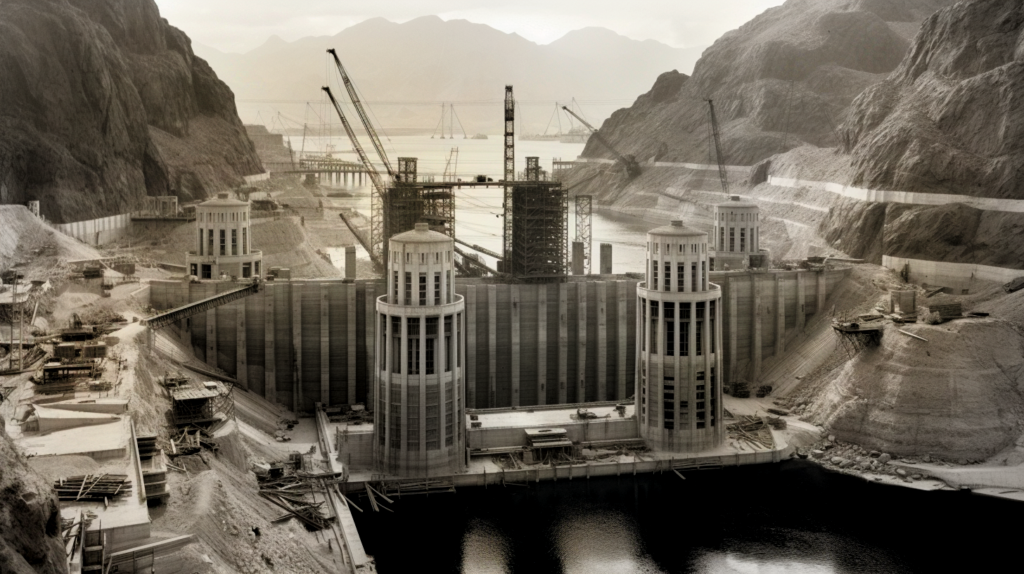Harnessing Nature’s Pulse – The Towering Tale of Hoover Dam’s Rise Amidst Rocky Vistas

In a land where the sun scorches the rugged terrain and the Colorado River snakes through with a fierce yet majestic grace stands a marvel of human engineering – the Hoover Dam. This colossal structure, nestled amidst the rocky vistas, is not merely a dam but a narrative of human tenacity, innovation, and a relentless quest to harness nature’s might for progress. As we traverse through history, the saga of Hoover Dam unfolds, painting a vivid picture of vision, audacity, and the indomitable spirit that sought to tame the wild heart of the Colorado River.
Table of Contents
The Genesis of a Colossal Vision
In the early 20th century, the arid lands of the American Southwest yearned for the nurturing touch of water to unlock their potential. It was Arthur Powell Davis, an engineer and the Director of the U.S. Reclamation Service, who first envisioned a high dam built in Boulder Canyon to control the mighty Colorado, foster irrigation, and generate hydroelectric power. His vision, although grand, laid the cornerstone for what would soon morph into a project of monumental significance – the Hoover Dam. The journey from conception to approval was a long one, filled with political debates and economic considerations, yet the seed of an ambitious dream had been sown.
The Herculean Undertaking
With the roaring 20s giving way to the grim 30s, the Great Depression cast a long, dark shadow across America. It was during these trying times, on March 4, 1931, that the contract to build the Hoover Dam was awarded to a consortium called Six Companies Inc. The clang of machinery and the hum of industrious enthusiasm filled the air as work commenced in the black canyons in earnest on July 7, 1931. The mammoth task ahead was not for the faint of heart; it demanded grit, expertise, and a relentless drive to breathe life into the towering vision amidst adversities.
Engineering Marvel Amidst a Harsh Cradle
The realm where the Hoover Dam was to rise was a domain of extremes: scorching temperatures, rugged terrain, and the relentless Colorado River that carved through the rocks with wild abandon. The construction site presented a formidable array of challenges, from the need to divert the mighty river to the task of excavating vast amounts of rock to the perilous work on towering heights amidst harsh weather conditions. Yet, under the diligent and audacious direction of chief engineer Frank Crowe, the army of workers, against the odds, began morphing the rugged canyon into a citadel of human engineering prowess.
The voyage through the history of the Hoover Dam is a sojourn through the annals of human audacity and innovation. Each chapter of its construction reveals tales of challenges met with unwavering resolve, of a community of workers bound by a common purpose, and of a nation watching with bated breath as a symbol of hope and progress rose amidst a land parched by the sun and carved by the river. The Hoover Dam stands today as a testament to a time when ambition met the unyielding spirit, leading to the birth of a monumental legacy etched in concrete and reverberating through the waters it commands.
How was the Dam Constructed?
The construction of Hoover Dam was a melody of machines, manpower, and meticulous planning. The first verse was about the diversion of the Colorado River, a Herculean task that demanded the creation of four massive diversion tunnels driven through the canyon walls. Once the mighty river was tamed, the stage was set for the dam to rise. An incessant pour of concrete commenced, with colossal blocks being laid and an orchestra of coolers and inspectors ensuring every inch cured to perfection. The dam gradually rose, each tier a testament to engineering acumen, until the final block was placed and the colossus stood complete, an embodiment of concrete ingenuity.
What Impact Did the Dam Have?
The completion of the Hoover Dam was more than a construction milestone; it was the birth of a lifeline. The dam’s colossal reservoir, Lake Mead, became a source of sustenance, providing water to the parched lands of the Southwest. The hydroelectric power generated illuminated cities fueled industries, and sparked economic growth amidst the gloom of the Depression era. The Hoover Dam had morphed from a vision to the heartbeat of a region, its impact reverberating through the lands it nurtured and the lives it touched. It wasn’t just a dam; it was a catalyst of hope and prosperity.
How Does Hoover Dam Stand Today?
As the years rolled by, the Hoover Dam transitioned from a marvel of its time to a timeless marvel. Today, it stands as a symbol of human endeavor, a tourist magnet, and an enduring source of water and power. The dam continues to serve its original purpose while charming visitors from across the globe who come to gaze upon this mammoth structure nestled amidst the rugged beauty of the Black Canyon. The Hoover Dam’s legacy is cast in concrete, etched in the annals of history, and celebrated in the tales of those who toiled to turn a monumental dream into a towering reality.
Conclusion
The narrative of the Hoover Dam is a saga that reflects the quintessence of the human spirit, ingenuity, and the relentless quest to harness nature’s bounty for progress. It’s a tale that resonates through the calm waters of Lake Mead, echoes through the power corridors it fuels, and lives on in the hearts of those who gaze upon this behemoth, a silent yet powerful testament to what can be achieved when daring dreams meld with unwavering resolve. Amidst the arid vastness of the Southwest, the Hoover Dam stands as a tribute to the visionaries of the past and an inspiration for the dreamers of the future.
Media credit: The conceptual image of the Hoover Dam history in Nevada in this article is copyright of VegasNews.com
